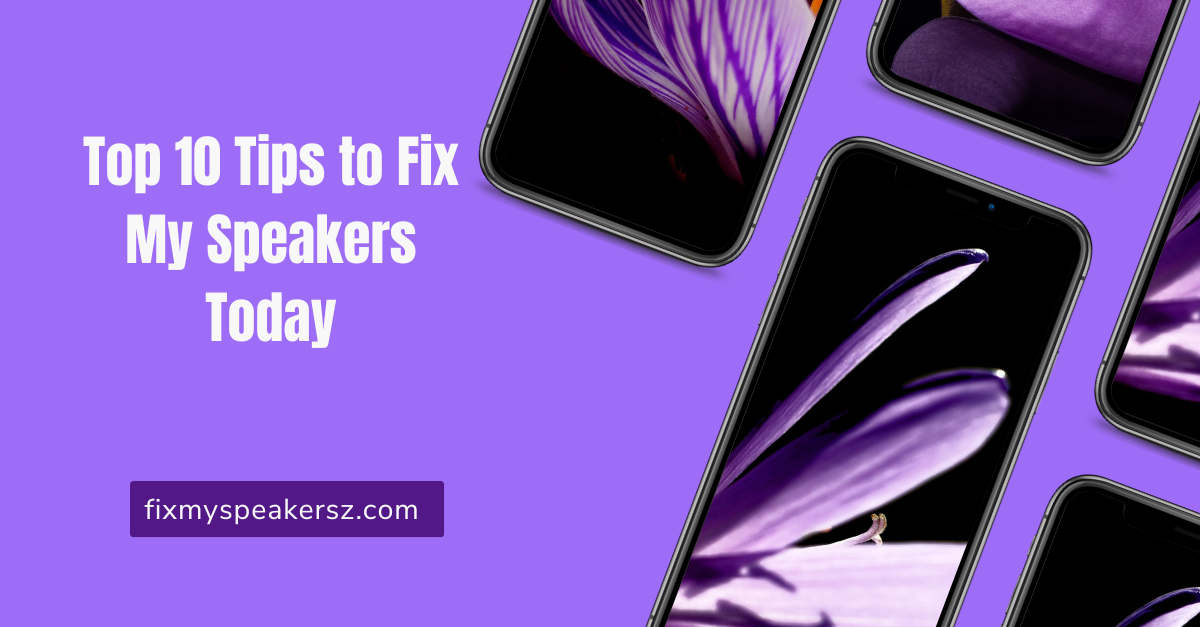Are your speakers giving you a hard time? Maybe there’s no sound, or worse—your favorite song sounds like it’s coming from underwater. If you're thinking, "How can I fix my speaker without calling a technician?" you're in the right place. Whether you're dealing with distorted audio, complete silence, or static crackling, we’ve got you covered with these top 10 tips to fix your speakers today.
Let's roll up our sleeves and bring the music back!

1. Check the Obvious: Is Everything Plugged In Properly?
Before diving into more complex fixes, let’s start with the basics. You’d be surprised how often the issue is just a loose cable or an unplugged speaker. Make sure:
- Power cables are firmly connected.
- Speaker wires are not frayed or broken.
- Audio jacks are fully inserted.
Sometimes the fix is just that easy. Boom—my speaker fix complete in 10 seconds!
2. Try a Different Audio Source
Is the problem really with your speakers? Or could it be your device?
Try connecting your speakers to a different laptop, phone, or TV. If the speakers work elsewhere, the issue might be your original device—not the speakers themselves.
This is a solid trick to isolate the issue and avoid wasting time fixing something that isn’t broken.
3. Inspect the Volume Controls
Yes, we know—you’ve probably checked the volume. But double-check:
- The physical volume knob on the speaker.
- The volume settings on your computer or phone.
- The app you’re using (like YouTube or Spotify).
Sometimes, one volume source is turned all the way down while the others are maxed out. That’s a silent killer—literally.
4. Update or Reinstall Audio Drivers (For Computer Users)
If you're trying to fix my speaker sound issues on a PC, outdated drivers might be to blame. Here’s how to fix it:
- Go to Device Manager.
- Click “Sound, video and game controllers.”
- Right-click your audio device and choose “Update driver.”
- Restart your PC after updating.
Still no sound? Try uninstalling the driver and reinstalling it. Sometimes fresh software brings dead audio back to life.
5. Clean Your Speaker Grilles
Speakers, like noses, need to breathe. Dust, lint, and pet hair can clog up the speaker grilles, especially if you haven’t cleaned them in a while.
Use a:
- Soft toothbrush
- Can of compressed air
- Microfiber cloth
This isn’t just for aesthetics—it can actually make your sound crisper. Who knew fix my speaker could be as simple as cleaning?
6. Use Audio Troubleshooter (Windows)
Windows has a built-in audio troubleshooter that’s surprisingly effective. Here’s how to use it:
- Go to Settings > System > Sound.
- Scroll down and click Troubleshoot.
- Follow the on-screen instructions.
It might not always give you the exact fix, but it often points you in the right direction.
7. Check Bluetooth Connection (For Wireless Speakers)
Trying to fix my speakers but you're using Bluetooth? Connection issues are common. Here’s what to do:
- Turn Bluetooth off and back on.
- Unpair and re-pair the device.
- Move the speaker closer to the source.
- Ensure no other device is hijacking the Bluetooth.
Pro tip: Restart both the speaker and the phone/computer—it works wonders.
8. Test with Different Cables
Cables wear out over time, especially if they’ve been twisted, bent, or chewed (we’re looking at you, pet owners). If your audio is cutting out or crackling:
- Try a new aux cable.
- Switch USB ports or USB cables.
- If using HDMI for sound, test a different HDMI cord.
A simple cable swap might just be the my speaker fix you've been looking for.
9. Reset the Speaker to Factory Settings
If you’ve tried everything and your speaker is still misbehaving, a factory reset might help. Most modern Bluetooth or smart speakers have a reset option.
- Check the user manual for the specific button combo.
- Resetting wipes out glitches and bugs.
- Re-pair your devices after the reset.
Think of this as turning your speaker's brain off and on again—a fresh start!
10. Listen for Physical Damage
If your speaker fell off a table or got wet recently, there might be internal damage. Here's what to check:
- Rattling: Something might be loose inside.
- Distorted sound: The speaker cone could be torn.
- No sound at all: Power components might be fried.
While these fixes are more hands-on (or may need professional help), you can often open cheaper speakers and do DIY repairs with some YouTube guidance and a soldering iron.
Bonus Tip: Apps That Help You Fix Speaker Sound
There are apps that help diagnose and even fix sound issues—especially on smartphones.
- Speaker Cleaner apps can push water and dust out using sound waves.
- Equalizer apps help fine-tune audio output.
Give these a try when you’re struggling to fix my speaker sound and don’t want to open up your device.
When Should You Replace Your Speakers?
If you've tried all these tips and your speakers still sound like a broken robot trying to sing, it may be time to replace them.
Watch for:
- Repeated cutting in and out
- Zero response after resets
- Physical damage beyond repair
Sometimes a new set of speakers is less frustrating than a complicated fix.
Prevention Tips for Long-Lasting Speakers
Want to avoid speaker problems in the future? Follow these:
- Keep speakers dry and dust-free.
- Avoid cranking the volume to max (distortion damages speakers).
- Store wires properly.
- Use surge protectors for electronic devices.
A little care goes a long way—treat your speakers like you treat your ears!
Final Thoughts
Fixing your speaker doesn't have to be rocket science. With these top 10 (plus a few bonus) tips, you're now fully equipped to troubleshoot, test, clean, and maybe even resurrect your audio gear. So the next time someone asks, “How do I fix my speaker?”—you’ll be the go-to expert.
Remember: most speaker issues are either connection, configuration, or cleanliness problems. Don’t panic. Breathe. And let the sound play on!
FAQs
1. Why is there no sound coming from my speaker?
It could be due to loose connections, muted volume, or a misconfigured audio output setting. Check your cables and volume first.
2. Can I fix distorted speaker sound at home?
Yes, often distortion is caused by dust buildup, damaged wires, or incorrect equalizer settings. Cleaning and adjusting EQ can help.
3. How do I reset my Bluetooth speaker?
Most Bluetooth speakers reset by holding the power button and another button (like Bluetooth or Volume+) for a few seconds. Check your manual.
4. My speaker works on one device but not another—why?
That means your speaker is fine. The problem is likely the audio settings or drivers on the device where it’s not working.
5. Are there mobile apps that can help fix my speaker?
Yes! Apps like “Speaker Cleaner” and “SoundAbout” can help clear blockages and troubleshoot speaker-related issues on smartphones.
